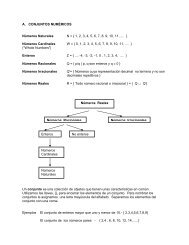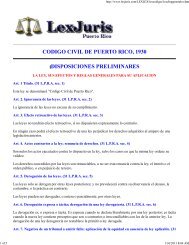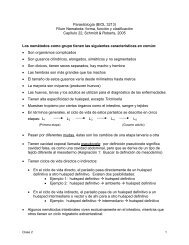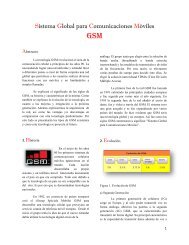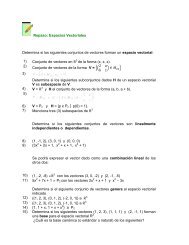CAM DESIGN
CAM DESIGN
CAM DESIGN
- No tags were found...
You also want an ePaper? Increase the reach of your titles
YUMPU automatically turns print PDFs into web optimized ePapers that Google loves.
Chapter 8<strong>CAM</strong> <strong>DESIGN</strong>
Introduction
Terminology• Type of Follower Motion– Rotating follower
Terminology• Type of Follower Motion– Translating follower
Terminology• Type of Joint Closure– Force
Terminology• Type of Joint Closure– Form
Terminology• Type of Follower– Flat-faced – Roller
Terminology• Type of Follower– Mushroom
Terminology• Type of Cam– Radial• Previous Figures– Axial
Terminology• Type of Motion Constrains– Critical Extreme Position (CEP)– Critical Path Motion (CPM)• Type of Motion Program– RF: rise-fall– RFD: rise-fall-dwell– RDFD: rise-dwell-fall-dwell
SVAJ Diagrams
Double-Dwell Cam
Double-Dwell Cam• Example 8.1 A Bad Cam!– Consider the following cam design CEPspecification• dwell• rise• dwell• fall• camat zero displacement for 90 degrees1 in (25 mm) in 90 degreesat 1 in (25 mm) for 90 degrees1 in (25 mm) in 90 degrees2π rad/sec
Double-Dwell Cam
Double-Dwell Cam• Fundamental Law of Cam Design– The cam function must be continuousthrough the first and second derivativesof displacement across the entireinterval (360 degrees)• The jerk function must be finite across theentire interval• Functions– Simple Harmonic Motion (SHM)– Cycloidal Displacement
Double-Dwell Cam– Combine» Constant Acceleration» Trapezoidal Acceleration» Modified Trapezoidal Acceleration» Modified Sinusoidal Acceleration– Sine-Constant-Cosine-Acceleration (SCCA)– Polynomials
Double-Dwell Cam– Simple Harmonic Motion (SHM)sin2cos2sin2cos123322hjhahvhs
Double-Dwell Cam– Cycloidal Displacement• Start with the acceleration function (sinewave)2sin212cos12cos42sin2322hshvhjha
Double-Dwell Cam– Combined Functions• Constant Acceleration
Double-Dwell Cam– Combined Functions• Trapezoidal Acceleration
Double-Dwell Cam– Combined Functions• Modified Trapezoidal Acceleration
Double-Dwell Cam– Combined Functions• Modified Trapezoidal Acceleration
Double-Dwell Cam– Combined Functions• Modified Sinunusoidal Acceleration
Double-Dwell Cam– Combined Functions• Modified Sinunusoidal Acceleration
Double-Dwell Cam– Sine-Constant-Cosine-Constant (SCCA)• A family of acceleration functions that includesconstant acceleration, simple harmonic, modifiedtrapezoid, modified sine, and cycloidal curves.• Expression for the functions within each zone aregiven in pages 413-415
Double-Dwell Cam– Sine-Constant-Cosine-Constant (SCCA)
Double-Dwell Cam– Comparison of five cam acceleration program• Acceleration
Double-Dwell Cam– Comparison of five cam acceleration program• jerk
Double-Dwell Cam– Comparison of five cam acceleration program• velocity
Double-Dwell Cam– Comparison of three cam acceleration program• displacement
Double-Dwell Cam– Polynomial Functionss C Cx Cx 2Cx 3Cx 4Cx 501• 3-4-5 Polynomial2345Cx nns Cv C2345 0 C1 C2 C3 C4 C5 23 1 C2 3C3 4C4 5 2 C5 4a2 2 6C3 12C4 20 2CC5 C 's are found from theBC'sC0,C1,C2are zero3
Double-Dwell Cams C– Polynomial Functions• 4-5 -6-7 Polynomial234567 0 C1 C2 C3 C4 C5 C6 C7 v C2345 1 C2 3C3 4C4 5C5 6C6 7 2 C7 234 2 6C3 12C4 20C5 30C6 42 a 2CC7 56C 's are found from theBC'sC0,C1,C2,C3are zero
Single Dwell Cam Design• Rise-Fall-Dwell (RFD)– Single-dwell cam specifications• rise:• fall:1 in (25.4mm) in 90 degrees1 in (25.4mm) in 90 degrees• dwell: at zero displacement for 180degrees(low dwell)• cam ω:15 rad/sec
Single Dwell Cam Design• Rise-Fall-Dwell (RFD)– Cycloidal Motion2sin212cos12cos42sin2322hshvhjha
Single Dwell Cam Design• Rise-Fall-Dwell (RFD)– Double Harmonicfor therise: 22sinsin22coscos22sin21sin22cos141cos123322hjhahvhs
Single Dwell Cam Design• Rise-Fall-Dwell (RFD)– Double Harmonic:for thefall 22sinsin22coscos22sin21sin22cos141cos123322hjhahvhs
Single Dwell Cam Design• Rise-Fall-Dwell (RFD)– Double Harmonic
Single Dwell Cam Design• Rise-Fall-Dwell (RFD)– Polynomials• Minimize the number of segments (2)• Minimize the number of boundary conditions• Redefine the CEP specifications• rise-fall:1 in (25.4 mm) in 90° and fall 1 in90° for a total of 180° (low dwell)• dwell: at zero displacement for 180°• Cam ω:15 rad/sec
Single Dwell Cam Design• Rise-Fall-Dwell (RFD)– Polynomials• Boundary Conditions
Single Dwell Cam Design• Rise-Fall-Dwell (RFD)– Polynomials
Single Dwell Cam Design• Rise-Fall-Dwell (RFD)– Polynomials (Asymmetrical)• Redefine the CEP specifications• rise-fall:1 in (25.4 mm) in 45° and fall 1 in135° for a total of 180° (low dwell)• dwell: at zero displacement for 180°• Cam ω:15 rad/sec• Two segments( Different order, 6 &7)• Three segments (segment with the smalleracceleration)
Single Dwell Cam Design• Rise-Fall-Dwell (RFD)– Polynomials (Asymmetrical)
Critical Path Motion• Most common application is forconstant velocity motion– intermittent– continuous– Typical problem• Accelerate the follower from zero to 10in/sec• Maintain a constant velocity of 10in/sec for 0.5 sec
Critical Path Motion– Typical problem• decelerate• return• cycle timethe follower to zero velocitythe follower to startpositionexactly 1 sec
Critical Path Motion
Critical Path Motion
Sizing• Major factor that affect cam size– Pressure angle– Radius of curvature– Base circle radius (flat)• The smallest circle that can be drawn tangentto the physical cam surface– Prime circle radius (roller or curved)• The smallest circle that can be drawn tangentto the locus of the centerline of the follower
Sizing
Sizing• Pressure angle– The angle betweenthe direction ofmotion (velocity) ofthe follower and thedirection of the axisof transmission• Between 0° and 30°
Sizing• Pressure angle– Eccentricity• Perpendiculardistance betweenthe follower’s axisof motion and thecenter of the camV I2,4 b b vs• The distance b tothe instant center isequal to the velocityof the follower
Sizing• Pressure angle arctans v 2R P2– Prime CircleRadius
Sizing• Pressure angle– Overturning –Translating Flat-Faced Follower
Sizing• Radius of Curvature (Roller)– No matter how complicated a curve’sshape may be, nor how high thedegree of the describing function, itwill have a instantaneous radius ofcurvature– Concerns• Large radius
Sizing• Radius of Curvature (Roller)– Concerns• Undercutting
Sizing• Radius of Curvature (Roller)– The rule of thumb is to keep theabsolute value of the minimum radiusof curvature of the cam pitch curve 2to 3 times as large as the radius ofthe follower min R fpitch2 23/ 2RP s v2R s 2v aR s2PP
Sizing• Radius ofCurvature (Flat)RAx vx facewidthminR bjRbs v maxv mins a minCam Contour; R ssinvcosq Rb scosvsinrb







